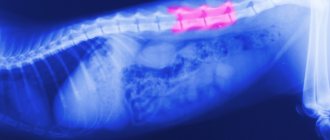In the article I will talk about the causes of tremors in pets, why a dog or cat is lethargic, tucks its tail, hind legs and begins to shake. What diseases is it caused by? Or is this a normal physiological reaction. When diagnostics and qualified assistance from a veterinarian are needed.
Pathological causes of trembling in dogs
In animals that have not been vaccinated, trembling may be caused by a viral disease.
The most dangerous are:
- Viral hepatitis (occurs in pets under 1 year of age), which affects the cornea, kidneys and liver. In addition to shaking, coordination is impaired. It can affect both a kitten and a puppy; they begin to whine and breathe rapidly. Paralysis and other nervous system disorders occur.
- Encephalomyelitis (develops at 5-8 years of age) – loss of coordination of movements occurs, limbs weaken. If left untreated, the animal becomes paralyzed.
- Parovirus enteritis (puppies are susceptible, also occurs in adults) – accompanied. It is urgent to begin treatment in the first 4 days of the disease, otherwise death is inevitable.
- Adenovirus – shaking, coughing appears, body temperature rises. With timely treatment, a dog or cat gets rid of the disease in 1.5-2 weeks. But within a few months the pet will be contagious to other animals.
- Carnivore plague – causes inflammation in the liver, kidneys, and brain. Symptoms are as follows: trembling, discharge from the eyes and nose, diarrhea, vomiting, fever, difficulty breathing, photophobia. The disease lasts from several weeks to several months. It can result in either the pet’s recovery or death.
Trembling can be a very specific sign in many poisonings
How often should you visit the veterinarian?
The frequency of visits to the veterinarian should be determined individually, based on the physical condition and age of the dog. There are recommendations for each age, which will be discussed further.
- Dog less than 1 year old: a monthly visit is recommended. It is up to one year that young pets need to have all the necessary vaccinations. The doctor also monitors the development and growth of the dog, whether there are any problems due to a lack of minerals, vitamins, and whether the development corresponds to age. A qualified doctor will definitely draw up a schedule of visits after a thorough examination of your pet. During this period, it is advisable to find a veterinarian who would monitor the dog throughout his life. A kind of family doctor, only for your beloved dog.
- Ages 1-7 years: Recommended annual examination. When the dog is one year old, you need to continue vaccinations according to the previously prescribed veterinary calendar. Don't forget about the annual examination, during which your pet will be thoroughly checked: ears, eyes, nose, heart, lungs, mouth. Only a detailed examination can guarantee the identification of possible symptoms of disease in certain organs. Based on the results of the visit to the veterinarian, recommendations regarding dental care, nutrition, physical activity, etc. will be offered. If there is a suspicion of illness, then additional examinations and tests will be prescribed.
- Ages 8 years and older: Visit your veterinarian every 6 months. Old dogs, like people, are at risk and are more susceptible to various diseases. For this reason, you should visit the veterinarian every six months. In addition to standard examinations, the doctor may prescribe urine, blood, stool tests, x-rays, ultrasound, and blood pressure measurements.
Cases when a trip to the veterinarian should not be postponed
When the dog feels well and no deviations in behavior are observed, it is necessary to visit the veterinarian according to a previously drawn up schedule. However, there are some emergency situations that require emergency assistance from a qualified specialist:
- severe breathing problems are observed;
- the dog was hit by a car;
- the pet does not wake up and is unconscious;
- the dog fell unsuccessfully from a height;
- incessant diarrhea and vomiting throughout the day, pale gums, diarrhea with blood;
- suspected paw fracture or other injury;
- the dog ate something poisonous;
- seizures with convulsions;
- the pet has fallen and does not get up;
- felt a tumor;
- the animal suddenly lost orientation in space;
- the dog whines, hides and trembles;
- other unnatural behavior of the pet.
The dog's hind legs are trembling: reasons, what to do
Parasitic diseases
Shivering in a dog can also be caused by parasitic organisms.
Among them:
- Helminthic infestation is infection by helminths. Accompanied by shaking during defecation.
- Dirofilariasis. When parasites enter an animal's body, they rush to the heart. The result is trembling, swelling, and a dry, frequent cough. The pet becomes apathetic.
- Piroplasmosis is blood poisoning from a tick bite. Symptoms of the disease: heavy breathing, shaking, brown urine, loss of balance.
Infection of a pet's body with parasites is also sometimes accompanied by the appearance of trembling.
What should the owner do?
Most of the pathological causes mentioned require urgent veterinary intervention. If you have the opportunity to visit a veterinary clinic in the near future, play it safe and check your pet.
Contacting a veterinarian
Detection of pathology in the early stages helps to avoid chronicity of the process and death of the animal. The most alarming signs include:
- repeated vomiting or diarrhea, especially with blood;
- remaining still and refusing to walk;
- the appearance of trembling not only in the hind legs, but also in other parts of the body;
- change in urine color;
- increased frequency and difficulty breathing.
After studying the tests, ultrasound, x-rays and other studies, the veterinarian will be able to make an accurate diagnosis and prescribe medication treatment. Depending on the severity of the situation, the animal may be left in the hospital or sent home.
Diseases of internal organs
Trembling may indicate disturbances in the functioning of the animal’s internal organs:
- Hypoglycemia is a lack of blood sugar in small breed dogs. Accompanied by shaking, lethargy, loss of strength. Hypoglycemia can be easily cured with one injection of glucose. If detected untimely, it causes paralysis of the limbs and death.
- Hypothyroidism (deficiency of thyroid hormones) – accompanied by trembling, weakness, and low body temperature.
- Heart disease (heart failure, myocarditis) – caused by trembling, irregular heartbeat, and frequent bowel movements.
- Inflammation of the spinal cord - accompanied by shaking and paralysis of the limbs.
- Eclampsia (drop in calcium levels) - appears in bitches during pregnancy and lactation. There is trembling, turning into convulsions, vomiting, high fever, shortness of breath.
Trembling may also indicate a disturbance in the functioning of internal organs.
Nausea
Before vomiting, some puppies become anxious and may tremble. If your puppy is vomiting and shaking due to emotional distress, he needs time to calm down. Your puppy may also experience nausea and tremors due to motion sickness, certain medications, or liver or kidney disease. Other signs of nausea in your puppy include lip smacking, swallowing, yawning, and drooling. When these signs of nausea appear, puppies almost always vomit.
Treatment for nausea in puppies depends on the cause. If you can't find the cause at home, it's best to take your puppy to the vet to diagnose any health problems. Conversely, nausea can also be caused by sudden changes in diet or stomach upset. This includes table scraps.
© shutterstock
Cold and hypothermia
Small and medium-sized dogs freeze outside without warm clothing. If you notice that your pet is shaking from the cold, you should not continue the walk. The pet may get sick and will have to be treated. Therefore, buy clothes for walking in the cold season that will make your dog comfortable.
Small breeds may shiver due to cold after bathing. If the room temperature is not high, but low, place a heater to warm the air. Wrap your pet in a towel. It can be dried with a hair dryer if it is not afraid. But you can’t leave an electrical appliance alone with your pet. Insulate the place where your pet sleeps by placing a blanket or wool bedding there.
If the trembling is due to physiological reasons, it is enough to eliminate their influence
Another reason for trembling is anxiety, excitement, and fear. The animal was frightened by the sound of thunder, the explosion of firecrackers, and was worried by the change of situation. Give her calming chamomile tea and protect her from stressful situations.
If you raise your voice at your pet and notice that he is trembling, stop. You risk losing your friend's friendship and breaking his psyche.
Cold weather
Puppies exposed to the cold for long periods of time may suffer from hypothermia. Mild hypothermia occurs when your puppy's body temperature drops between 37°C and 32°C. If your puppy has mild hypothermia, it can be treated at home. Bring your puppy inside, dry him off, and place him in a warm place. Moderate hypothermia refers to a temperature between 32°C and 28°C. If your puppy has mild hypothermia, he will need more time to recover. Warm a towel or blanket in the clothes dryer and wrap it around your puppy. With severe hypothermia, the temperature is below 28°C.
Severe hypothermia requires emergency medical attention. Your puppy may pass out, stop shaking, and have an alarmingly slow heart rate. If this sounds like your puppy, seek emergency veterinary attention. During the car ride, you will need to dry your puppy and wrap him in warm blankets. Your veterinarian will gently warm your puppy by administering warm IV fluids, oxygen, and supportive heat therapy. Most dogs recover well from hypothermia, especially after veterinary treatment.
Symptoms of neurosis
Pathology manifests itself both at the physical and psycho-emotional levels. Physical symptoms include increased sweating, rapid heartbeat, chest pain and dry mouth, headaches, blurred vision, tremors of the limbs, skin rashes, and menstrual irregularities in women.
Psychological symptoms: a feeling of loss of control, a feeling that the person is “going crazy”, fear of sudden death, excessive worry, high sensitivity and vulnerability.
- Irritability;
- Constant feeling of fatigue and apathy;
- Increased sensitivity;
- Social isolation;
- Frequent and unexpected mood swings;
- Disturbances in sleep and wakefulness;
- Loss of interest in life or certain areas of it.
It is the constant feeling of anxiety for one’s life or the lives of loved ones that causes insomnia in a person. Problems with sleep do not allow the body and nervous system of those suffering from neurasthenia to fully rest. This, in turn, further intensifies all the symptoms listed above.
Therefore, for insomnia, experts recommend several simple and effective rules:
- Follow a daily routine, that is, try to fall asleep and wake up at the same time;
- Play sports, giving the body a light load;
- Be in the fresh air more often;
- Reduce the number of drinks containing caffeine;
- Eat light foods to avoid stomach discomfort.
For what reasons does neurosis develop?
- Strong mental activity;
- Prolonged psychological distress and anxiety;
- Psychological pressure due to the inability to solve life problems;
- Long-term loneliness and problems in the personal sphere of life;
- Traumatic event in life: loss of a loved one, difficult divorce, difficult financial situation, if the person has been subjected to emotional and physical abuse, etc.;
- High expectations. In this case, the person cannot achieve the desired goal and experiences a feeling of an impossible plan;
- Psychological trauma received in childhood: humiliation or beating from peers and parents, example of a bad lifestyle from adults, harsh upbringing;
- Failure to comply with work and rest schedules.
Happiness/Excitement
Most puppies tremble when they feel happy or excited. This is because strong emotions trigger the release of adrenaline in the body. Adrenaline triggers the animal's fight or flight response. This helps the body react faster. The heart beats faster, blood flow to the brain increases, and the ability to feel pain even decreases. Your dog may experience this reaction when he is happy to see you or is expecting a walk. This reaction is most often seen in younger dogs with less impulse control.
Your puppy's extreme nervousness upon arriving home may reflect an anxiety disorder. If your puppy is destructive when you leave, can't stand being away from you, and reacts strongly when you come home, he may be struggling with separation anxiety. Some cases of canine anxiety can be treated with training.
In mild cases, counterconditioning can help your puppy associate a negative situation with something positive. This may include offering expensive foods and toys that are only given out when you leave. Moderate to severe cases require a more complex training program. This involves getting your puppy used to being alone through many short separations, gradually increasing the duration over many weeks. Desensitization is a long and complex process.
Kidney failure
If your puppy has kidney failure, it means his kidneys have stopped working properly. Kidney failure is caused by dehydration, illness, infection, or ingestion of toxins. If your puppy has kidney failure, he may urinate more often and drink more often. The puppy may tremble and may also exhibit vomiting and nausea, lethargy, weight loss, and mouth ulcers. Chronic kidney failure can also cause tremors, muscle twitching, or even seizures. These symptoms develop when minerals accumulate in the blood.
Treatment depends on your puppy's condition. In cases of acute renal failure, the kidneys may require dialysis. Dialysis is a medical procedure to remove waste products from the blood. Chronic kidney failure, on the other hand, is treated primarily through diet changes, various medications, and fluid therapy. Unfortunately, chronic kidney disease is irreversible and progresses over time.
Convulsions
Epilepsy is a condition that causes repeated seizures. Seizures occur when abnormal electrical activity occurs in the brain. Focal seizures occur in one side of the brain. They cause facial twitching, head shaking, dilated pupils, and unexplained fearful behavior. On the other hand, generalized seizures affect both hemispheres of the brain. These seizures may be tonic, clonic, tonic-clonic, or myoclonic. In most common seizures, your puppy will lose consciousness and experience involuntary motor movements throughout the body. Not all seizures are related to a shaking puppy. Your puppy may also have non-convulsive atonic seizures, also called drop attacks. This results in a sudden loss of muscle tone, causing the puppy to become unconscious.
If your puppy has a seizure, remain calm. Most seizures are short-lived and your puppy most likely is not even aware of the seizures. Move furniture out of the way to avoid injuring your pet. Under no circumstances should you put any objects, including your hands, into your puppy's mouth. If you can, note the duration of the seizure and write down the symptoms to show your veterinarian. Your veterinarian may put your puppy on antiepileptic drug (AED) therapy for the rest of his life. These drugs include phenobarbital, potassium bromide, levetiracetam, and zonisamide. While an AED may not completely stop your puppy's seizures, most owners find that their puppies' seizures are reduced by 50 percent.
"Safe" convulsions
If a dog's paw twitches while sleeping as a puppy, this is evidence of the immaturity of the part of the central nervous system responsible for the movement of norepinephrine in the brain. This substance is produced by the adrenal medulla, but due to the same immaturity, too much of it is released at the moment when the puppy experiences strong emotions.
The baby, like a child, absorbs everything that the world around him offers, falls asleep, relaxes, and the subcortex at this moment still works. Emotional outbursts are expressed in the form of muscle tremors, involuntary movements, and stretching.
In addition to young dogs, similar conditions can occur in adult dogs with an easily excitable psyche. Zoologists explain this phenomenon by disturbing dreams and call it “puppy” tremors. It is not considered a pathology if development proceeds according to norms, but it can manifest itself as whining in sleep, shaking of the paws and ears, and small twitches. It is enough to caress your pet, talk in a quiet soothing voice and the trembling will stop. It is recommended to take emotional, excitable animals out for walks in unfamiliar places more often - this strengthens the nervous system.











